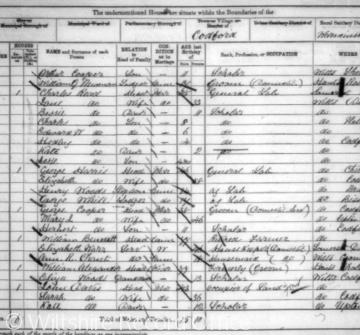Census Returns
 A page from the Codford St Mary entry in the 1881 census
A page from the Codford St Mary entry in the 1881 censusIn 1801 a census was taken, which was probably not completely accurate. It was followed every ten years by much more careful and detailed inquiries into the population, parish by parish.
Some schedules survive in parishes for 1821 and 1831 but few have names. They provide details of the number of families, houses and people engaged in different occupations. From 1841 names are recorded and from 1851 there are also details of age, marital status, birthplace, relationships, occupation and disability, people living rough or on boats, and where houses were being built. Farmers gave details of acreage cultivated and all employers provided numbers of employees.
In 1841 details of emigration were asked for, and later censuses recorded the number of habitable rooms in dwellings and whether unoccupied houses were temporarily empty or had been abandoned. There is information about boundary changes and new parishes, boarding schools, hospitals and workhouses, and the naming, and later numbering, of town streets.
Census schedules cast light on poverty and wealth, family and household size, the growth of towns, suburbs and back courts, businesses, shops and factories, domestic service, migration, schools and hospitals, farm size and amalgamation, crafts, and travellers, lodgers and visitors.
There is also one ecclesiastical census for 1851 with detailed information on every place of worship open at the time including seating capacity and size of congregation.










